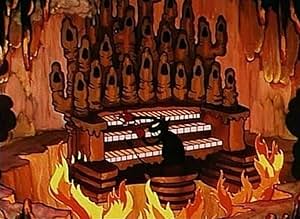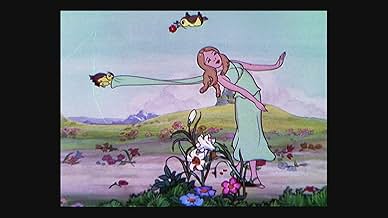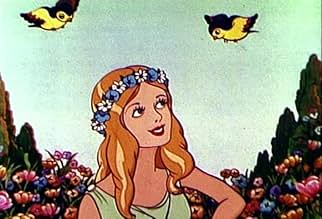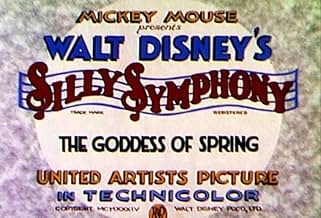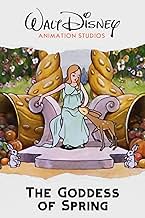IMDb RATING
6.6/10
1.5K
YOUR RATING
The lovely goddess of spring, Persephone, is kidnapped by Hades, thus bringing about the winter season.The lovely goddess of spring, Persephone, is kidnapped by Hades, thus bringing about the winter season.The lovely goddess of spring, Persephone, is kidnapped by Hades, thus bringing about the winter season.
- Director
- Writer
- Stars
Kenny Baker
- Singing Narrator
- (voice)
- (uncredited)
Jessica Dragonette
- Goddess of Spring
- (voice)
- (uncredited)
Tudor Williams
- Pluto
- (voice)
- (uncredited)
- Director
- Writer
- All cast & crew
- Production, box office & more at IMDbPro
Featured reviews
As the Snow White Platinum DVD notes, The Goddess of Spring served mostly as practice for the Disney animators on how to properly animate humans for Snow White & the Seven Dwarfs. Not only did they improve on animating humans, I thought they also greatly improved on drawing backgrounds, animals, and the dwarf-like creatures that appeared in The Goddess of Spring. While The Goddess of Spring is an animated short with a much smaller budget, the difference between the dwarfs in this cartoon and Snow White are as different as night and day. The dwarfs in Goddess of Spring were all drawn the same with no unique personalities, whereas Snow White's dwarfs are all unique in both appearance and personality.
I've also read that people were impressed with how well the hell sequences were drawn in Goddess of Spring. I have to admit that I wasn't really impressed when I saw it. I thought the sequences were too bland and a little too bright for a depiction of hell. I was actually more impressed with the hell sequences drawn in 1929's Hell's Bells, one of the first, rare Silly Symphonies drawn by Ub Iwerks.
However, I will say that I did somewhat enjoy the story of Goddess of Spring, which uses mythology to explain why we don't have everlasting spring. The opera style was kind of corny though. I just didn't get the sense that Disney animators concentrated too much on this short, but rather just as practice for Snow White. Nevertheless, I guess Goddess of Spring fulfilled its mission, because Snow White is one of the greatest, most landmark films in the history of cinema.
My IMDb Rating: 5/10
I've also read that people were impressed with how well the hell sequences were drawn in Goddess of Spring. I have to admit that I wasn't really impressed when I saw it. I thought the sequences were too bland and a little too bright for a depiction of hell. I was actually more impressed with the hell sequences drawn in 1929's Hell's Bells, one of the first, rare Silly Symphonies drawn by Ub Iwerks.
However, I will say that I did somewhat enjoy the story of Goddess of Spring, which uses mythology to explain why we don't have everlasting spring. The opera style was kind of corny though. I just didn't get the sense that Disney animators concentrated too much on this short, but rather just as practice for Snow White. Nevertheless, I guess Goddess of Spring fulfilled its mission, because Snow White is one of the greatest, most landmark films in the history of cinema.
My IMDb Rating: 5/10
PiThis is obviously the story of Hades and Persephone. As the beauty of summer gives way to winter, she is forced to live underground in a sort of hell. There's more to the story, but suffice it to say that this was an explanation for the change of seasons. Spring is a beautiful young woman and Hades is the stereotypical devil (not really the Greek entity). His operatic voice is stunning and his pleasing must be fore eternity. She is always going tor return.
A Walt Disney SILLY SYMPHONY Cartoon Short.
Persephone, THE GODDESS OF SPRING, is kidnapped by Hades, the devilish god of the Underworld, leaving the earth in perpetual winter. Will the warmth & joy of Spring ever return?
A vivid, and somewhat bizarre, little film which retells the story from Greek Mythology, while incorporating both operatic & jazz traditions. The animators seem to have confused the character of Hades with that of the Biblical Satan. Years later, Walt would draw comparison between Persephone & Snow White, to illustrate how far his animators evolved in just three short years.
The SILLY SYMPHONIES, which Walt Disney produced for a ten year period beginning in 1929, are among the most fascinating of all animated series. Unlike the Mickey Mouse cartoons in which action was paramount, with the Symphonies the action was made to fit the music. There was little plot in the early Symphonies, which featured lively inanimate objects and anthropomorphic plants & animals, all moving frantically to the soundtrack. Gradually, however, the Symphonies became the school where Walt's animators learned to work with color and began to experiment with plot, characterization & photographic special effects. The pages of Fable & Fairy Tale, Myth & Mother Goose were all mined to provide story lines and even Hollywood's musicals & celebrities were effectively spoofed. It was from this rich soil that Disney's feature-length animation was to spring. In 1939, with SNOW WHITE successfully behind him and PINOCCHIO & FANTASIA on the near horizon, Walt phased out the SILLY SYMPHONIES; they had run their course & served their purpose.
Persephone, THE GODDESS OF SPRING, is kidnapped by Hades, the devilish god of the Underworld, leaving the earth in perpetual winter. Will the warmth & joy of Spring ever return?
A vivid, and somewhat bizarre, little film which retells the story from Greek Mythology, while incorporating both operatic & jazz traditions. The animators seem to have confused the character of Hades with that of the Biblical Satan. Years later, Walt would draw comparison between Persephone & Snow White, to illustrate how far his animators evolved in just three short years.
The SILLY SYMPHONIES, which Walt Disney produced for a ten year period beginning in 1929, are among the most fascinating of all animated series. Unlike the Mickey Mouse cartoons in which action was paramount, with the Symphonies the action was made to fit the music. There was little plot in the early Symphonies, which featured lively inanimate objects and anthropomorphic plants & animals, all moving frantically to the soundtrack. Gradually, however, the Symphonies became the school where Walt's animators learned to work with color and began to experiment with plot, characterization & photographic special effects. The pages of Fable & Fairy Tale, Myth & Mother Goose were all mined to provide story lines and even Hollywood's musicals & celebrities were effectively spoofed. It was from this rich soil that Disney's feature-length animation was to spring. In 1939, with SNOW WHITE successfully behind him and PINOCCHIO & FANTASIA on the near horizon, Walt phased out the SILLY SYMPHONIES; they had run their course & served their purpose.
I can't believe I didn't see "The Goddess of Spring" before now. It is truly wonderful and unique, and I would definitely would have liked it as a kid, as I adore animation and classical music. The animation here is stunning, the upper world is so tranquil and like a paradise. Even better are the hell sequences, with dark background contrasts and a somewhat creepy atmosphere. The music is absolutely outstanding, the lyricality of the classical music of the upper world, and the sinister, perhaps even distorted Cab Calloway-inspired jazz music of hell. Then the characters, the secondary characters are sweet and endearing, not with unique personalities like the Seven Dwarfs in "Snow White" but sweet enough. Persephone is so gorgeous and pure, and Hades? In a good way he is truly diabolical, with towering presence, sinister appearance and a resonant Wagnerian-like bass voice. Overall, I loved this Silly Symphony. 10/10 Bethany Cox
There may be no better example of emergence of cinematic genius than to watch this and then see "Snow White."
This is a study in human modelling, in the context of dwarfs and nature. Its after the style of the Betty Boop work that controlled expectations on the animated screen with a little bit more grace. But it still features thin figures with cartoon movements rather than human ones. It was done as a test for Snow White.
Almost nothing here was used in that later project and its a good thing. There is nothing attractive about it at all.
But I can still see a serious attempt at finding that vocabulary of movements that seems human but isn't, looks natural and warm but is abstract and seems to capture a version of womanhood without referencing sex. Its only hinted here and perfected in a way later. I'm not at all sure if we can know whether in Snow White Walt and company touched something we knew, or whether he created something that we grew into with our ideals and imagination. I believe it is the latter, which makes this experiment more interesting.
Suppose he would have stuck with what he had here. Would we have grown around it and adapted a wholly different vision of innocent perfection?
Ted's Evaluation -- 2 of 3: Has some interesting elements.
This is a study in human modelling, in the context of dwarfs and nature. Its after the style of the Betty Boop work that controlled expectations on the animated screen with a little bit more grace. But it still features thin figures with cartoon movements rather than human ones. It was done as a test for Snow White.
Almost nothing here was used in that later project and its a good thing. There is nothing attractive about it at all.
But I can still see a serious attempt at finding that vocabulary of movements that seems human but isn't, looks natural and warm but is abstract and seems to capture a version of womanhood without referencing sex. Its only hinted here and perfected in a way later. I'm not at all sure if we can know whether in Snow White Walt and company touched something we knew, or whether he created something that we grew into with our ideals and imagination. I believe it is the latter, which makes this experiment more interesting.
Suppose he would have stuck with what he had here. Would we have grown around it and adapted a wholly different vision of innocent perfection?
Ted's Evaluation -- 2 of 3: Has some interesting elements.
Did you know
- TriviaWalt Disney and his animators used this short as a test to see if they could create realistic animation, a style they would later perfect in Blanche-Neige et les Sept Nains (1937).
- ConnectionsFeatured in Once Upon a Mouse (1981)
Details
- Release date
- Country of origin
- Official site
- Language
- Also known as
- A Greek Myth
- Production company
- See more company credits at IMDbPro
- Runtime10 minutes
- Aspect ratio
- 1.37 : 1
Contribute to this page
Suggest an edit or add missing content

Top Gap
By what name was La déesse du printemps (1934) officially released in Canada in English?
Answer
